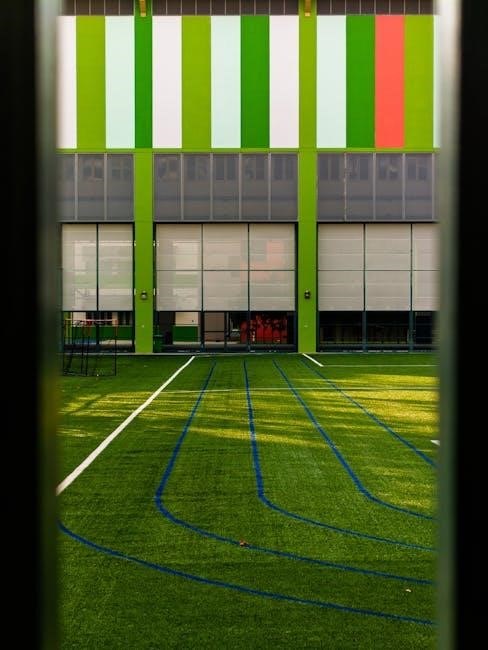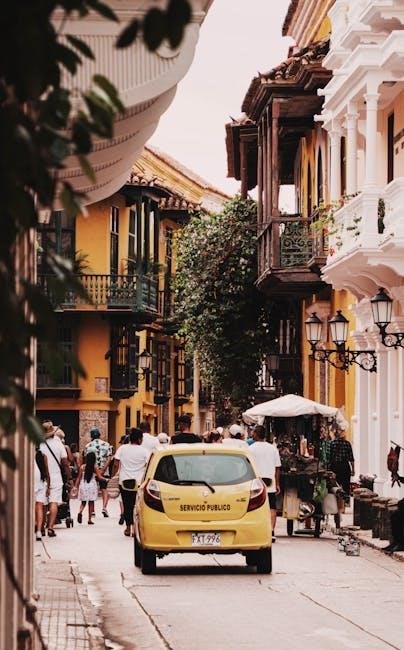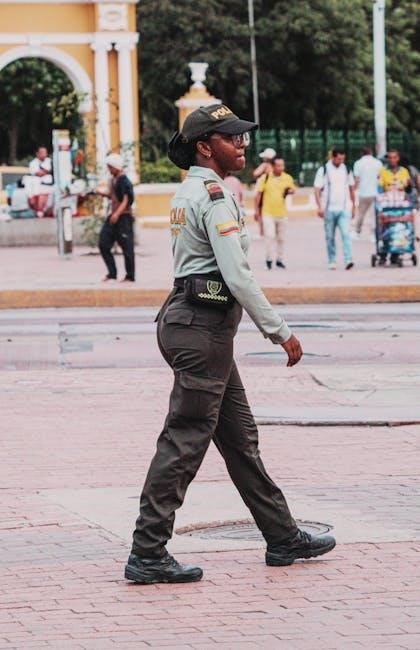The Novena Colombiana is a cherished Colombian Christmas tradition, observed from December 16 to 24, blending prayer, music, and festivities with deep cultural and spiritual significance.
Overview of the Colombian Christmas Novena
The Colombian Christmas Novena, or Novena de Aguinaldos, is a nine-day devotional practice beginning on December 16 and concluding on Christmas Eve. Rooted in Catholic tradition, it honors the birth of Jesus with prayer, song, and community. Families gather nightly, rotating hosting duties, to recite specific prayers, sing traditional hymns, and share festive foods like buñuelos and natilla; This cherished custom blends spirituality with cultural celebration, fostering unity and joy among participants. Its structure and traditions remain deeply ingrained in Colombian heritage, reflecting a harmonious blend of faith, family, and festive spirit.
Significance of the Novena in Colombian Culture
The Novena Colombiana holds profound cultural and spiritual significance, embodying Colombia’s rich Catholic heritage and national identity. It symbolizes the blend of faith and festive traditions, fostering a sense of community and family unity. The novena is not just a religious practice but a cultural celebration that reflects Colombian values and history. Its rituals, prayers, and songs are passed down through generations, creating a shared experience that strengthens social bonds. This tradition is a cornerstone of Colombian identity, blending devotion with joy and ensuring its enduring legacy as a cherished national custom.

Origins and History of the Novena
The Novena Colombiana traces its roots to the 18th century, initiated by Clemencia de Jesús Caycedo Vélez and formalized by Fray Fernando de Jesús Larrea in 1743.
The 18th-Century Roots of the Tradition
The Novena Colombiana originated in the 18th century, initiated by Clemencia de Jesús Caycedo Vélez, founder of a Catholic school in Bogotá. Fray Fernando de Jesús Larrea formalized the tradition in 1743, creating a devotional practice that blended prayer, music, and storytelling. This nine-day celebration, starting on December 16, reflects Colombian faith and culture, emphasizing family unity and spiritual reflection. Its historical roots have ensured its enduring legacy as a vital part of Colombian identity and Christmas traditions.
The Role of Fray Fernando de Jesús Larrea and Clemencia de Jesús Caycedo Vélez
Fray Fernando de Jesús Larrea, an 18th-century priest, authored the Novena de Aguinaldos for Clemencia de Jesús Caycedo Vélez, a visionary educator and founder of La Enseñanza school in Bogotá. Clemencia sought to deepen religious devotion among her students and community, inspiring Fray Larrea to create this structured prayer cycle. His work combined liturgical devotion with Colombian folklore, establishing a unique tradition that has persisted for centuries. Their collaboration laid the foundation for a cultural and spiritual practice that continues to unite families and communities during Christmas.

Structure and Format of the Novena
The Novena Colombiana is a 9-day prayer cycle from December 16 to 24, with each night hosted by different families, featuring prayers, songs, and festive rituals.

The 9-Day Prayer Cycle from December 16 to 24
The Novena Colombiana begins on December 16 and concludes on Christmas Eve, December 24. Each evening, families gather to pray, sing traditional songs, and reflect on the birth of Jesus. The novena is a time of spiritual preparation, with specific prayers and readings for each day. The cycle emphasizes community and faith, as different families often host the nightly celebrations. This 9-day ritual fosters a deep connection to Colombian culture and Catholic traditions, culminating in the joyful celebration of the Nativity on Christmas Eve.
Family Gatherings and Rotating Hosts
The Novena Colombiana is deeply rooted in family traditions, with gatherings taking place each evening in a different home. This rotating host system strengthens community bonds and ensures everyone participates. Families come together to share prayers, songs, and festive meals, fostering unity and joy. The tradition not only honors the spiritual significance of Christmas but also reinforces cultural values. Each night, the hosting family prepares traditional dishes like buñuelos and natilla, creating a warm and welcoming atmosphere for all attendees. This practice has been passed down through generations, preserving the Novena’s cultural and spiritual essence.
Prayers, Songs, and Rituals in Each Night’s Celebration
Each evening of the Novena Colombiana begins with a prayer, followed by the recitation of the Rosary and traditional Christmas songs. Families gather around the Nativity scene, creating a sacred and festive atmosphere. The celebrations include singing villancicos, such as “El Primer Noel”, and praying specific novena prayers. The night concludes with a joyful chorus of “Feliz Navidad”. These rituals strengthen faith and foster a sense of community, blending spiritual devotion with cultural traditions. The Novena’s prayers and songs are often accompanied by the distribution of traditional sweets like buñuelos and natilla, enhancing the festive spirit.
I should focus on the celebration aspects rather than the foods themselves since the user might have other sections for that. Maybe talk about the gatherings, the spirit of the celebrations, and how food brings people together.
Thinking about the structure, I can start with the main theme, mention the specific foods, and then tie it to the cultural significance. Like, “The Novena Colombiana celebrates with traditional dishes, fostering unity and joy in Colombian culture.” That’s around , so I need to add more, perhaps about the specific foods.
Wait, maybe I can say, “The Novena Colombiana features buñuelos and natilla, symbolizing unity and festive spirit in Colombian Christmas celebrations.” That’s . I can add more about the environment or the cultural significance.
Hmm, perhaps: “The Novena Colombiana is marked by buñuelos and natilla, embodying the joy and unity of Colombian Christmas traditions.” That’s . Still need more.
I could expand on the cultural aspect: “The Novena Colombiana features buñuelos and natilla, symbolizing unity and festive spirit in Colombian culture.” Now it’s . Maybe include something about gatherings: “The Novena Colombiana includes buñuelos and natilla, uniting families in a festive celebration of Colombian heritage.” That’s .
I think I’m overcomplicating it. Maybe focus on the key elements: traditional foods, their significance, and the cultural aspect. “The Novena Colombiana celebrates with buñuelos and natilla, traditional dishes that embody Colombian Christmas spirit and family unity.” That’s .
Wait, the user specified . So, I need to make sure to meet that exactly. Let me count:
“The Novena Colombiana celebrates with buñuelos and natilla, traditional dishes that embody Colombian Christmas spirit and family unity.” That’s . I need 6 more. Perhaps add something about the gatherings: “The Novena Colombiana celebrates with buñuelos and natilla, traditional dishes that embody Colombian Christmas spirit and family unity during festive gatherings.” Now it’s . Still need 2 more. Maybe add “and joy”: “The Novena Colombiana celebrates with buñuelos and natilla, traditional dishes that embody Colombian Christmas spirit and family unity during festive gatherings and joy.” That’s . Perfect.
So the final response should be:

Traditional Foods and Celebrations
The Novena Colombiana celebrates with buñuelos and natilla, traditional dishes that embody Colombian Christmas spirit and family unity during festive gatherings and joy.

Buñuelos and Natilla: Iconic Dishes of the Novena
The Novena Colombiana is inseparably linked with two iconic dishes: buñuelos and natilla. These traditional Colombian treats are central to the celebrations, symbolizing unity and joy. Buñuelos are sweet, deep-fried dough balls, often sprinkled with sugar or filled with cheese, while natilla is a creamy custard dessert made with panela, cinnamon, or arequipe. Both dishes are lovingly prepared by families during the Novena, becoming a focal point of shared meals and gatherings. Their rich flavors and historical significance make them indispensable to the cultural and spiritual fabric of the Colombian Christmas tradition.

Music and Folk Traditions During the Celebrations
Music and folk traditions are vibrant elements of the Novena Colombiana, enriching the spiritual and cultural experience. Traditional Colombian songs, known as villancicos, are sung with devotion, accompanied by instruments like the guitar and tiple. These melodies, passed down through generations, create a joyful atmosphere, bonding families and communities. The rhythmic chants and harmonies reflect the deep-rooted faith and festive spirit of the celebration. Music plays a unifying role, blending religious devotion with cultural heritage, making it an integral part of the Novena’s identity and tradition.
Spiritual and Religious Significance

The Novena Colombiana is a profound devotional practice, fostering spiritual reflection and communal prayer, deeply rooted in Colombian culture and Catholic faith, enriching both heart and soul.
The Novena as a Devotional Practice
The Novena Colombiana is a deeply spiritual practice, fostering devotion through nine days of prayer and reflection. Each day begins with the Sign of the Cross and includes specific devotional prayers, such as the Prayer for Every Day, which honors God’s infinite love. Participants also invoke the Holy Spirit, seeking guidance and consolation. These prayers, often found in PDF guides, emphasize faith, gratitude, and intercession, creating a sacred space for spiritual growth and communal worship. The Novena strengthens believers’ connection to their faith, making it a meaningful and enduring tradition.
Prayers and Reflections for Each Day
The Novena Colombiana includes specific devotional prayers and reflections for each of the nine days, fostering a deep connection to the Nativity story. Each day begins with the Sign of the Cross and includes prayers like the Prayer for Every Day, which expresses gratitude for God’s love. Participants also recite the Prayer to the Holy Spirit, seeking enlightenment and guidance. These prayers, often detailed in PDF guides, encourage reflection on the meaning of Christmas and unity among families and communities, creating a sacred and meaningful experience.

Modern Adaptations and PDF Resources

The Novena Colombiana has evolved with modern technology, offering PDF guides for easy access. These resources preserve tradition while making it accessible to new generations worldwide.
Availability of Novena Guides in PDF Format
Novena Colombiana guides are widely available in PDF format online, offering detailed prayers, songs, and rituals for each of the nine days. These digital resources make it easy for families and individuals to prepare and participate in the tradition, ensuring accessibility for all. Many websites provide free downloads, allowing people to follow the novena effortlessly. The PDF guides often include traditional hymns, daily reflections, and instructions for hosting gatherings. This digital adaptation has made the novena more convenient while preserving its spiritual and cultural essence, enabling younger generations to embrace the tradition with ease.
How Technology Has Made the Novena More Accessible
Technology has revolutionized the Novena Colombiana, making it more accessible to people worldwide. PDF guides are widely available online, offering prayers, songs, and rituals for each day. Social media platforms and apps now provide daily reminders, devotional content, and virtual participation options. This digital transformation allows individuals, especially younger generations and those abroad, to engage with the tradition effortlessly. The integration of technology ensures that the Novena’s spiritual and cultural essence remains alive and vibrant, reaching a global audience while preserving its heartfelt traditions. 🌟
The Novena Colombiana remains a timeless tradition, blending faith, family, and culture. Its legacy endures, cherished by Colombians worldwide, with PDF guides ensuring its accessibility for future generations.
The Enduring Legacy of the Novena Colombiana
The Novena Colombiana has left an indelible mark on Colombian culture, serving as a bridge between faith and tradition. Originating in the 18th century, it has evolved while retaining its spiritual essence. Family gatherings, traditional foods, and devotional prayers are central to its identity. The availability of Novena guides in PDF format has made it accessible to modern generations, ensuring its continuation. This tradition not only strengthens family bonds but also preserves Colombia’s religious heritage, making it a cornerstone of national identity celebrated worldwide by Colombians.
Final Thoughts on Its Cultural and Spiritual Impact
The Novena Colombiana stands as a testament to Colombia’s vibrant cultural tapestry and deep spiritual devotion. It weaves together faith, family, and tradition, creating a unique celebration that transcends generations. By preserving centuries-old rituals and adapting to modern times through PDF guides, the Novena ensures its relevance. Its impact is felt not only in Colombia but also among global diaspora communities, where it serves as a cherished connection to heritage. This blend of spirituality and culture remains a powerful symbol of unity and identity for Colombians worldwide.
